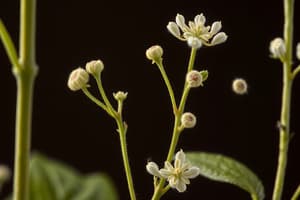Podcast
Questions and Answers
What is the characteristic feature of a sucker?
What is the characteristic feature of a sucker?
- Horizontally growing underground stem
- Lateral branch with short internode and each node bearing a rossette of leaves and tuft of roots at base
- Main stem growing in the soil horizontally and branches developing obliquely from nodes above the soil (correct)
- Reduced stem with disc-like structure and numerous fleshy scaly leaves
What is the function of underground stem modifications?
What is the function of underground stem modifications?
- Food storage and vegetative propagation (correct)
- Supporting the plant above ground
- Protecting the plant from herbivores
- Conducting water and minerals to the plant
What is a rhizome?
What is a rhizome?
- A fleshy and horizontally growing stem found below the soil surface (correct)
- A type of leaf modification
- A type of root
- A type of stem modification found above ground
What is a corm?
What is a corm?
What is the purpose of the 'eyes' found on tubers?
What is the purpose of the 'eyes' found on tubers?
What is a phylloclade?
What is a phylloclade?
What is an offset?
What is an offset?
What is a characteristic feature of a bulb?
What is a characteristic feature of a bulb?
What type of inflorescence has florets that may be unisexual, bisexual, and sterile?
What type of inflorescence has florets that may be unisexual, bisexual, and sterile?
What is the term used to describe an inflorescence with a branched peduncle, where each branch bears a spike?
What is the term used to describe an inflorescence with a branched peduncle, where each branch bears a spike?
What is the characteristic feature of Asteraceae family?
What is the characteristic feature of Asteraceae family?
What is the type of cyme where the peduncle ends in a flower and from the base of it many lateral branches arise?
What is the type of cyme where the peduncle ends in a flower and from the base of it many lateral branches arise?
In a catkin, what is the peduncle like?
In a catkin, what is the peduncle like?
What is the arrangement of flowers in a cyme called?
What is the arrangement of flowers in a cyme called?
What is the term used to describe an inflorescence with a thick, long, and fleshy peduncle?
What is the term used to describe an inflorescence with a thick, long, and fleshy peduncle?
What type of cyme has lateral branches that develop on the same side of the peduncle?
What type of cyme has lateral branches that develop on the same side of the peduncle?
In a corymb, what is the arrangement of flowers?
In a corymb, what is the arrangement of flowers?
What is the term used to describe an inflorescence with a branched peduncle, where each branch has a flower cluster?
What is the term used to describe an inflorescence with a branched peduncle, where each branch has a flower cluster?
What type of cyme has lateral branches that develop alternately on left and right side of the peduncle?
What type of cyme has lateral branches that develop alternately on left and right side of the peduncle?
Which of the following is an example of a heterogamous inflorescence?
Which of the following is an example of a heterogamous inflorescence?
In an umbel, what is the arrangement of flower stalks?
In an umbel, what is the arrangement of flower stalks?
What surrounds a heterogamous inflorescence?
What surrounds a heterogamous inflorescence?
What is the term used to describe an inflorescence with a branched peduncle, where each branch has a flower cluster, in plants like coriander?
What is the term used to describe an inflorescence with a branched peduncle, where each branch has a flower cluster, in plants like coriander?
What is the term used to describe an inflorescence with a retarded and broad peduncle?
What is the term used to describe an inflorescence with a retarded and broad peduncle?
What is the term used to describe a leaf having more than four leaflets?
What is the term used to describe a leaf having more than four leaflets?
What type of phyllotaxy is characterized by a single leaf arising at each node?
What type of phyllotaxy is characterized by a single leaf arising at each node?
Which of the following types of heterophylly is due to aquatic adaptation?
Which of the following types of heterophylly is due to aquatic adaptation?
What is the term used to describe a leaf that is modified into a thin thread-like structure?
What is the term used to describe a leaf that is modified into a thin thread-like structure?
Which of the following plants exhibits decussate phyllotaxy?
Which of the following plants exhibits decussate phyllotaxy?
What is the term used to describe the occurrence of more than one type of leaves on the same plant?
What is the term used to describe the occurrence of more than one type of leaves on the same plant?
Which of the following plants exhibits habitual heterophylly?
Which of the following plants exhibits habitual heterophylly?
What is the term used to describe a leaflet that is modified into a tendril-like structure?
What is the term used to describe a leaflet that is modified into a tendril-like structure?
What type of androecium is found in Cotton, Hollyhock, and Ladyfinger?
What type of androecium is found in Cotton, Hollyhock, and Ladyfinger?
In which type of cohesion are anthers as well as filaments of stamens united through their whole length?
In which type of cohesion are anthers as well as filaments of stamens united through their whole length?
What is the term for when stamens are attached to petals?
What is the term for when stamens are attached to petals?
In which type of cohesion are filaments united into more than two bundles?
In which type of cohesion are filaments united into more than two bundles?
What is the term for when stamens are attached to tepals?
What is the term for when stamens are attached to tepals?
In which type of cohesion are anthers united in a bundle but filaments remain free?
In which type of cohesion are anthers united in a bundle but filaments remain free?
What is the term for when the floral parts of similar whorl are fused?
What is the term for when the floral parts of similar whorl are fused?
When the stamens of an androecium are free from one another, it is called what?
When the stamens of an androecium are free from one another, it is called what?
Flashcards are hidden until you start studying
Study Notes
Plant Morphology
Underground Stem Modifications
- Sucker: a stem that grows horizontally in the soil, with branches developing obliquely from nodes above the soil (e.g., Mint, Pineapple, Chrysanthemum)
- Offset: a lateral branch with short internodes, each node bearing a rossette of leaves and a tuft of roots at the base (e.g., Pistia, Eichhornia)
- Tuber: the tip of an underground branch that becomes swollen in the soil, with eyes (axillary buds) covered by scaly leaves (e.g., Potato, Helianthus tuberosus)
- Rhizome: a fleshy, horizontally-growing stem found below the soil surface, with small nodes and internodes covered by scaly leaves (e.g., Ginger, Turmeric, Canna, Water lily, Banana)
- Corm: a condensed structure that grows vertically under the soil surface, with spherical nodes and internodes (e.g., Colocasia, Alocasia, Zaminkand, Saffron, Gladiolus, Colchicum)
- Bulb: a stem that is reduced and has a disc-like structure, surrounded by numerous fleshy, scaly leaves; many roots arise from its base (e.g., Onion, Garlic)
Special Stem Modifications
- Phylloclade: a green, photosynthetic, flattened or rounded succulent stem with leaves that are either feebly developed or modified into spines (e.g., Opuntia, Casuarina, Euphorbia, Cactus)
- Thorn: a modification of an axillary bud (e.g., Bougainvillea, Duranta, Carissa)
Phyllotaxy
- Alternate or spiral: single leaf arising at each node (e.g., Cyperus rotandus, Chinarose, Mustard, Sunflower)
- Opposite: leaves occurring in pairs at each node
- Decussate: leaves that stand at right angles to the next upper or lower pair (e.g., Calotropis, Mussaenda)
- Superposed: successive pairs of leaves standing directly over a pair in the same plane (e.g., Psidium, Ixora)
- Whorled: more than two leaves at each node (e.g., Nerium, Alstonia)
Heterophylly
- Developmental Heterophylly: leaves of different forms and shapes occur at different periods or places on the same plant (e.g., Mustard, Sonchus, Eucalyptus)
- Environmental Heterophylly: an aquatic adaptation commonly found in rooted emergent hydrophytes, where submerged leaves differ from floating and aerial leaves (e.g., Limnophila, Heterophylla, Ranunculus aquatiles, Sagittaria)
- Habitual Heterophylly: due to habit, mature leaves differ in their shape and incisions (e.g., Artocarpus, Jack fruit)
Modifications of Leaves
- Leaf Tendril: a whole leaf modified into a thin, thread-like structure (e.g., Lathyrus aphaca, Wild pea)
- Leaflet Tendril: a leaflet modified into a tendril-like structure (e.g., Pisum sativum, Garden pea, Lathyrus odoratus, Sweet pea)
- Leaf Spine: leaves or any part of a leaflet modified into a pointed spine (e.g., Achyranthes)
Inflorescence
- Spike: an inflorescence with a peduncle that is branched and each branch bears a spikelet (e.g., Family Gramineae)
- Catkin: an inflorescence with a thin, long, and weak peduncle, with flowers that are sessile and unisexual (e.g., Mulberry, Betula, Oak)
- Spadix: an inflorescence with a thick, long, and fleshy peduncle, with small sessile and unisexual male and female flowers covered by one or more green or colorful bracts (e.g., Colocasia, Maize, Aroids, Palms)
- Corymb: an inflorescence with a short peduncle and all flowers present at the same level, due to the lower flower having a longer pedicel than the upper one (e.g., Candytuft, Iberis amara)
- Umbel: an inflorescence with flower stalks of different lengths, arising from the same point, with a whorl of bracts forming the involucre (e.g., Centella)
- Capitulum / Racemose Head: an inflorescence with a broad, flattened, or concave peduncle, with small flowers arranged on it (e.g., Sunflower, Zinnia, Marigold, Cosmos)
Cymose Inflorescence
- Uniparous Cyme / Monochasial Cyme: an inflorescence with a peduncle that terminates in a flower, producing a lateral branch at a time (e.g., Heliotropium, Saraca, Atropa, Datura)
- Dichasial or Biparous Cyme: an inflorescence with a peduncle that ends in a flower, from which two lateral branches arise, which also terminate in flowers (e.g., Bougainvillea, Jasmine, Teak, Mirabilis, Dianthus, Nyctanthes)
- Multiparous Cyme / Polychasial: an inflorescence with a peduncle that ends in a flower, from which many lateral branches arise, which also terminate in flowers (e.g., Michelia, Champa, Magnolia)
Stamens
- Basifixed: filament attached to anther by its base (e.g., Datura, Radish, Mustard)
- Dorsifixed: filament attached to the back of the anther (e.g., Passion flower)
- Versatile: filament attached to the back of the anther at a point only, allowing the anther to swing freely (e.g., Wheat, Grass, Maize)
Cohesion of Stamens
- Adelphous: when stamens are united by their filaments only (e.g., Cotton, Hollyhock, Ladyfinger)
- Diadelphous: when filaments are united in two bundles, but anthers remain free (e.g., Gram, Pea, Bean)
- Polyadelphous: when filaments are united into more than two bundles (e.g., Citrus, Castor)
- Synandrous: when anthers as well as filaments of stamens are united through their whole length (e.g., Colocasia, Alocasia, Momordica, Cucurbitaceae family)
- Syngenesious: when only anthers are united in a bundle, but filaments remain free (e.g., Compositae family)
Adhesion of Stamens
- Epipetalous: when stamens are attached to petals (e.g., Brinjal, Datura, Tobacco, Sunflower, Potato)
- Epiphyllous: when stamens are attached to tepals (e.g., Onion, Lily)
Studying That Suits You
Use AI to generate personalized quizzes and flashcards to suit your learning preferences.





